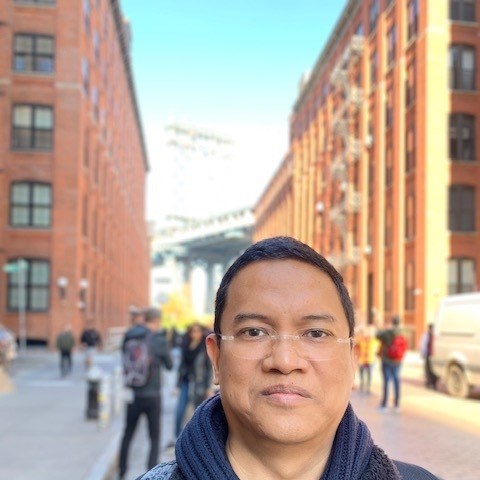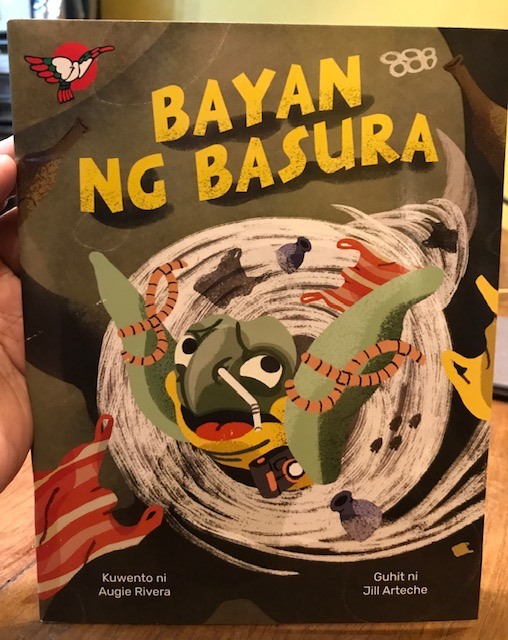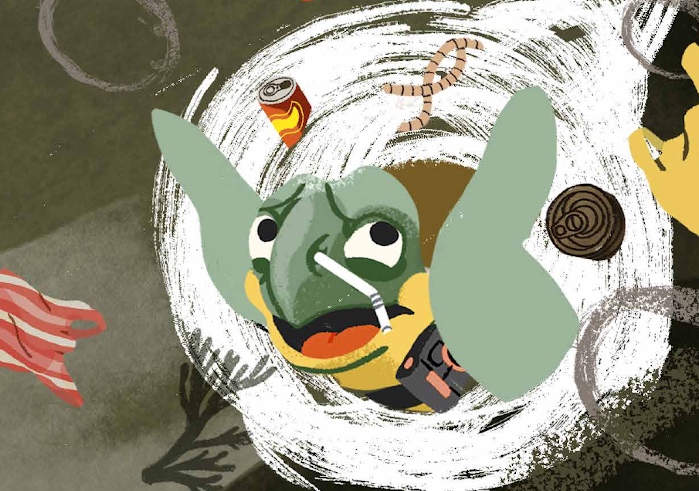Writer Augie Rivera has been putting informative content for children into the mouths of talking puppet animals and animated fruits and veggies for close to three decades.
A head writer in the ’90s for the iconic children’s show Batibot — a Sesame Street-like affair featuring a talking turtle called Pong and a human host called Kuya (Brother) Bodjie — Rivera has schooled kids on everything from the alphabet to character building.
Now, Rivera has collaborated with Greenpeace and Adarna House publishing to launch his latest infotainment offering aimed at youngsters, Bayan Ng Basura (literally, “Garbage Town”), released in December.
The book, Rivera’s 19th, is meant to teach kids how plastic waste, along with heaps of other trash, ends up in oceans and endangers marine life. It follows a pawikan (Philippine sea turtle) whose life is upended after a storm strews its undersea home with garbage. The book features art by illustrator Jill Arteche, whose cover shows the worried reptile swimming in a vortex of ocean-borne plastics, with a plastic straw lodged in its nose (more on its real-life inspiration later).

“For me, I guess one of the hardest things about writing for children is research,” Rivera told Coconuts Manila via email.
“Every little bit of info, lesson, insight, or detail that you put in must be carefully checked… researched, [and] well-thought-out.”
Even in an era of YouTube and a slew of educational apps, Rivera maintains that kids can still be reached by more old-school means.
“[Children] are very busy, but they will give up their precious time at play, on their computer or tablet, video games, etc. just to read your book, or watch your film or TV program. So don’t shortchange them.”
Rivera recently chatted with Coconuts Manila about how educating and entertaining kids has changed since he first burst onto the scene in the ‘90s with his beloved book Alamat ng Ampalaya (“Legend of the Bitter Gourd”), and what people can do about the country’s trash problem.
What made you decide to chose a pawikan (sea turtle) over other sea animals for your book Bayan ng Basura? Did you come across research about Philippine pawikans that contributed to your decision to put them front and center, or was it something more personal?
In developing my story for Bayan ng Basura, I drew inspiration from real-life cases of animals that fell victim to environmental abuse and neglect. In past episodes of our long-running infotainment show Ang Pinaka (“The Most”) on GMA News TV, we did several “animals-in-the-news” episodes, and it was there that I came across the story of an Olive Ridley sea turtle caught off the coast of Costa Rica with a plastic straw lodged in its nostril. That inspired me to use [a] pawikan as my main character. I based the story’s almost post-apocalyptic world under the sea on shocking footage of a British diver swimming in a Bali ocean teeming with all sorts of plastic garbage. You can check it out on YouTube.
You’ve won a Don Carlos Palanca Award for Literature for children’s shorts several times in the past, and you also founded the writers’ group KUTING (Kuwentista ng mag Tsikiting, or “Storyteller of Kids”). What made you decide to pick this genre specifically?
I got into writing for children when I first worked as writer — and eventually head writer — for the award-winning children’s TV show Batibot in 1993. I stayed on til 1999. I learned a lot from the experience, got exposed to hundreds of children’s programs from all over the world, fell in love with the genre, had fun exploring its possibilities, and gained a newfound respect for children as an audience.
What’s the most difficult part about writing for children? And the easiest?
For me, I guess one of the hardest things about writing for children is research, which forms part of my pre-[production] work for any project. I learned this discipline from my years in Batibot — where every little bit of info, lesson, insight, or detail that you put in must be carefully checked and/or researched, well-thought-out, and age-appropriate. Your target audience is very busy, but they will give up their precious time at play, on their computer/tablet, video games, etc. just to read your book, or watch your film/TV program. So don’t shortchange them. Always aspire to give them the best.
On the other hand, the easiest thing about it is that I love what I do.
Do you have any children of your own? If you could only make them read just one of your books, besides Bayan ng Basura, what would it be?
No, I don’t have children, but I have a chorkie [a Chihuahua-Yorkshire Terrier mix] named Hachiko. I would always recommend my original tale, Alamat ng Ampalaya (“Tale of the Bitter Gourd”), which wasn’t the first story that I wrote, but my first published work, way back 1995. So, the book is celebrating its 25th year of publication this year.
What are your thoughts on the children’s literature scene in the Philippines, and how do you think ours compares with other countries in Asia or the world?
We live in interesting times. I grew up in the late ‘70s to ‘80s when there were not that many locally-made books and other content for children. So I’m happy and honored that I’m still writing now, when a lot of local book authors, illustrators, storytellers, and publishers have also taken on this noble profession of creating literature for children.

How has the way kids consume entertainment these days affect your storytelling process? Is there a difference in the way you write and tell stories now, versus when you wrote Alamat ng Ampalaya in the ‘90s?
Well, the internet has definitely made it easier for me to do my own pre-[production] — research, interview, character studies, etc. — before I could even develop and write my story. My writing process, though, I think remains the same. When I wrote Alamat ng Ampalaya in 1995, I had to personally go to the market to research on my would-be characters, the different veggies! Prior to that, I didn’t even know how a mustasa (mustard plant) looks like!
By the way, we especially liked the anecdote about how ampalaya (bitter gourd) wasn’t in the children’s song Bahay Kubo (“Nipa Hut”), which is the reason you wrote Alamat ng Ampalaya. Any other similar interesting trivia you can share about your other books or Bahay ng Basura?
There are so many! It’s so hard to remember them all. I wrote XILEF after a school visit, and it was my first interaction with children with dyslexia. I co-wrote Magnificent Benito and his Two Front Teeth with my wife, Mike Rivera, and we did it “dugtungan-style” (fill-in-the-blanks style). Isang Harding Papel (“A Paper Garden”) is loosely based on the experiences of a cousin whose mother was a political detainee during the Martial Law. Pitong is based on World War II experiences of my father.
Besides being written for children, what’s the common denominator, or theme if you will, in the books you’ve published over the years?
Bayan ng Basura is actually my nineteenth children’s book. No, I don’t think there’s a conscious effort or decision on my part to write on just a single theme. I’ve done a series of historical fiction, Batang Historyador (“Kid Historian”), and books that you can probably group under “children in difficult circumstances” — i.e. martial law, incest, verbal abuse, child labor, online sexual exploitation of children, etc. But I want to keep my options open and be able to write on a wide variety of topics and themes.
Have you ever thought of writing for adults? Or do you already do that?
I also do write for adults in my other writing projects. In fact, most of the TV programs that I do now are geared towards an older audience or general patronage market. But if ever I would write for a young adult or teen audience market, it would probably be for a musical or a coming-of-age film.
On a side note, do you personally think the Philippines’ trash problem is getting better or worse? Do you feel like there’s enough education and discussion about it in recent years? Why do you think it’s easy for people not to care?
I live in Marikina, and I think we have a more “eco-friendly” way of dealing with our trash problems. Personally, even before I took on this project with Greenpeace and Adarna, I’ve already become conscious in following a more “eco-friendly” lifestyle — I always bring an eco-bag, I bring reusable straws and utensils, I refuse single-use plastics, I segregate my trash, etc. It can be quite hard, but every little effort helps when it comes to taking care of our environment.
This interview has been lightly edited and condensed for clarity.
Read more lifestyle stories at Coconuts Manila here.





